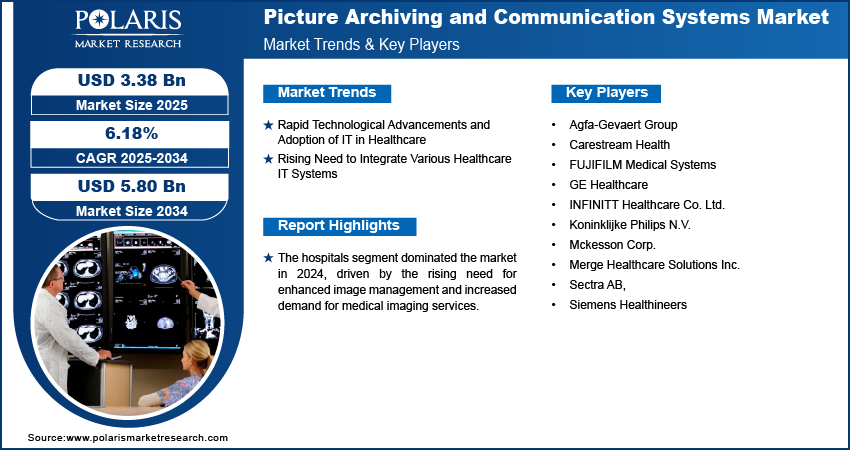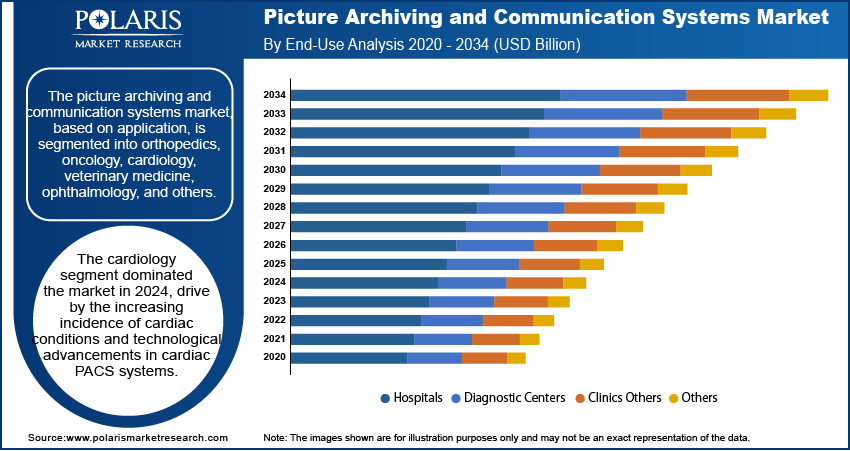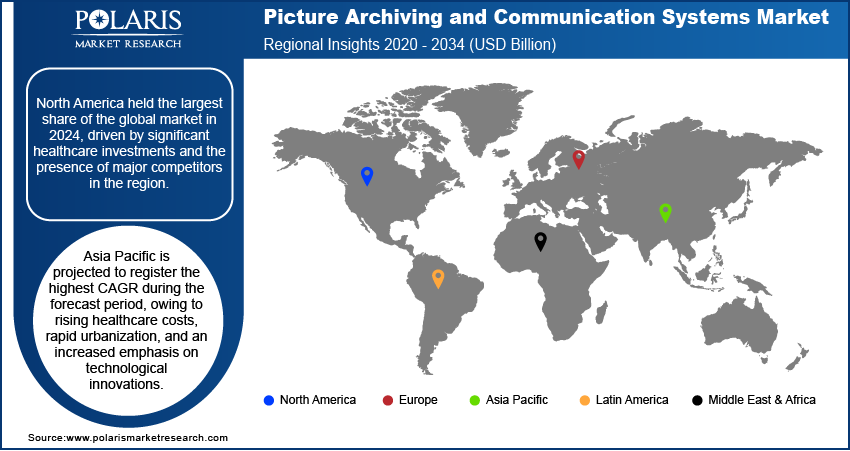
Picture Archiving and Communication Systems (PACS) Market Size, Share, Trends, Industry Analysis Report
: By Product (Mid End PACS, Enterprise PACS, and Mini PACS), Deployment, Application, End Users, and Region (North America, Europe, Asia Pacific, Latin America, and Middle East & Africa) – Market Forecast, 2025–2034
- Published Date:Aug-2025
- Pages: 117
- Format: PDF
- Report ID: PM1515
- Base Year: 2024
- Historical Data: 2020-2023
Market Overview
The global picture archiving and communication systems (PACS) market size was valued at USD 3.19 billion in 2024, growing at a CAGR of 6.18% from 2025 to 2034. The market demand for PACS is primarily driven by the rising aging population globally and the growing prevalence of chronic conditions.
Key Insights
- The cardiology segment led the market in 2024, driven by the growing incidence of cardiac conditions and technological advancements in cardiac PACS systems.
- The hospitals segment accounted for the largest revenue share in 2024, driven by the need for easy access to medical imaging across hospitals owing to their numerous departments and specialties.
- North America dominated the market in 2024, driven by significant healthcare investments and the presence of major competitors in the region.
- Asia Pacific is projected to register the highest CAGR during the projection period, driven by rising healthcare costs and increased emphasis on innovation in the healthcare sector.
Industry Dynamics
- Technological advancements in PACS, which have improved patient care and streamlined workflow, are driving market expansion.
- The rising need for the integration of various healthcare IT systems, which is seamlessly facilitated by PACs, is fueling market demand.
- Growing emphasis on efficient healthcare data management is anticipated to provide various market opportunities in the coming years.
- The high initial implementation costs may present challenges to market growth.
Market Statistics
2024 Market Size: USD 3.19 billion
2034 Projected Market Size: USD 5.80 billion
CAGR (2025-2034): 6.18%
North America: Largest Market in 2024
AI Impact on Picture Archiving and Communication Systems (PACS) Market
- The use of AI accelerates image analysis within PACS. It enables faster diagnosis by prioritizing critical cases and highlighting abnormalities.
- Machine learning algorithms enhance image compression and retrieval. This improves storage efficiency without compromising quality.
- The use of AI supports automated annotation and tagging of medical images, streamlining workflows and reducing radiologist workload.
- Integration with AI enables predictive analytics and decision support tools, turning PACS into a more proactive and intelligent diagnostic platform.
-Market.png)
To Understand More About this Research: Request a Free Sample Report
A picture archiving and communication (PACS) system is a digital system that stores, retrieves, and shares medical images and reports. It is used in healthcare organizations to improve patient care and diagnosis. PACS acquires images from medical imaging devices such as computed tomography (CT scans), magnetic resonance imaging (MRI) scans, and ultrasound, stores the images in a centralized computer system, and transmits the images to physicians digitally. With PACS, physicians can access images on multiple workstations simultaneously.
PACS provides several advantages over conventional systems, such as time savings, enhanced system reliability, space efficiency, reduced staff and consumable costs, improved data management, better picture accessibility, and educational benefits. The aging population globally and the increasing prevalence of chronic illnesses are driving the picture archiving and communication market growth. The rising need for effective data storage and archive technologies and the development of cloud-based PACS systems are also contributing to the market expansion.
The rising number of government initiatives, including favorable reimbursement policies, to promote the adoption of advanced health information technology is driving the PACS market development. The growing need to integrate patient photographs with electronic medical records and health information exchange platforms is expected to provide various market opportunities in the coming years. Additionally, the introduction of innovative products and expansion of R&D activities is impacting the market growth favorably.
Market Dynamics
Rapid Technological Advancements and Adoption of IT in Healthcare
Technological advancements in Picture Archiving and Communication Systems (PACS) include integration with RIS, DICOM-based images, and integration with EHR. These advancements have improved patient care, streamlined workflow, and enhanced collaboration. The adoption of IT in healthcare, such as artificial intelligence (AI) and cloud computing, is helping the Picture Archiving and Communication System (PACS) market grow. The picture archiving and communication system (PACS) market is being driven by the increased use of diagnostic imaging to identify a variety of ailments, as well as the expanding use of healthcare IT infrastructure. The increasing use of cloud-based technologies in an integrated healthcare system to enhance digital processes lends more confidence to this.
Rising Need to Integrate Various Healthcare IT Systems
Data sharing and the integration of different healthcare IT systems are important in healthcare to provide comprehensive and patient-centered care. The seamless integration of PACS with electronic health records (EHRs) and radiology information systems (RISs) ensures a more efficient and productive workflow. PACS eliminates complex data groups that could affect timely decision-making, enhancing patient data and medical imaging accessibility. Additionally, the interoperability of PACS systems makes it easier for healthcare networks to share information. As more healthcare professionals recognize the need to have complete patient data, there is a growing demand for PACS that can readily integrate with several systems. This, is turn, is driving the picture archiving and communication systems market expansion.

Segment Insights
Picture Archiving and Communication Systems Market Evaluation by Application Insights
The picture archiving and communication system market, based on application, is segmented into orthopedics, oncology, cardiology, veterinary medicine, ophthalmology, and others. The cardiology segment led the market with a 23.6% revenue share in 2024. Cardiology PACS can integrate with various systems, including cath lab hemodynamics systems, cardiac imaging systems, patient electronic medical records (EMR), and electrocardiogram (ECG). This enables healthcare professionals to compile all images and cardiac patient data in one place. The increasing incidence of cardiac conditions and technological advancements in cardiac PACS systems contribute to the segment’s leading position in the market.
The oncology segment is anticipated to register the highest CAGR of 8.9% during the forecast period, driven by the growing prevalence of cancer cases. As the number of cancer patients rises, there is a greater need for dependable and effective systems to manage medical images related to oncology, including pathology slides, radiology scans, and other diagnostic imaging modalities. PACS offers a secure and centralized platform for storing, retrieving, and sharing these images across healthcare facilities, thereby driving the segment’s robust growth.
Picture Archiving and Communication Systems Market Assessment by End Users Insights
Based on end users, the picture archiving and communication systems market is segmented into diagnostic centers, hospitals, clinics, and others. The hospitals segment accounted for the largest revenue share in 2024. Hospitals need easy access to medical imaging because of their numerous departments and specialties. Hospitals are actively adopting and utilizing the technology to manage and access medical imaging data digitally, leading to improved workflow efficiency, faster diagnosis, and enhanced patient care, thereby driving market demand for PACS systems across the healthcare industry. Furthermore, the requirement for these systems to manage and store substantial amounts of high-resolution images has increased due to developments in imaging technology, such as 3D imaging and 4D imaging.

Regional Analysis
By region, the report offers the picture archiving and communication systems market insights into North America, Europe, Asia Pacific, Latin America, and the Middle East and Africa. North America led the global market with a 41.2% revenue share in 2024. This is primarily attributed to significant healthcare investments and the presence of major competitors in the region. In addition, rising consumer spending and technological advancements in medical imaging technology contribute to the regional market dominance.
Asia Pacific is projected to register the highest CAGR during the forecast period due to its rising healthcare costs, rapid urbanization, and increasing emphasis on innovations in the healthcare sector. Other factors contributing to the regional market growth are the rising demand for digital solutions and improving healthcare infrastructure in emerging economies. The implementation of favorable government programs to enhance healthcare delivery and the increasing use of cloud-based solutions by healthcare providers further drive the market expansion in the region.

Key Players and Competitive Insights
The leading players are introducing innovative products in the PACS market to cater to the growing demand for consumers. Also, they are entering new markets in developing regions to expand their customer base, strengthen their market presence, and increase their market share. To expand and survive in a more competitive environment, market participants must offer innovative solutions.
In recent years, the market has witnessed several technological and innovation breakthroughs, with key players seeking to provide advanced solutions that help meet sustainability goals. The leading players in the market include Carestream Health, FUJIFILM Medical Systems, Agfa-Gevaert Group, Merge Healthcare Solutions Inc., INFINITT Healthcare Co. Ltd., Mckesson Corp., GE Healthcare, Koninklijke Philips N.V., Sectra AB, and Siemens Healthineers.
List of PACS Market Key Players
- Agfa-Gevaert Group
- Carestream Health
- FUJIFILM Medical Systems
- GE Healthcare
- INFINITT Healthcare Co. Ltd.
- Koninklijke Philips N.V.
- Mckesson Corp.
- Merge Healthcare Solutions Inc.
- Sectra AB
- Siemens Healthineers
Picture Archiving and Communication Systems Industry Developments
In May 2023, the US Food and Drug Administration (FDA) granted 510(k) clearance for clinical use of Augmento, DeepTek.ai's AI-powered radiology workflow management solution. The platform tackles the issue of a shortage of radiologists by introducing AI responsibly and cleanly, revolutionizing radiology workflows and improving patient care, quality, and productivity.
In September 2022, Rady Children’s Hospital, a leader in pediatric health care, announced the introduction of Media2DICOM, an advanced digital imaging and communications in medicine (DICOM) standardization software. The company stated the freely available software was created in-house at its Helen and Will Webster Foundation 3D Innovations (3DI) Lab.
Picture Archiving and Communication Systems Market Segmentation
By Product Outlook
- Mid End PACS
- Enterprise PACS
- Mini PACS
By Deployment Outlook
- Cloud-Based
- Web-Based
- On-Premise
By Application Outlook
- Orthopedics
- Oncology
- Cardiology
- Veterinary Medicine
- Ophthalmology
- Others
By End User Outlook
- Diagnostic Centers
- Hospitals
- Clinics
- Others
By Regional Outlook
- North America
- US
- Canada
- Europe
- Germany
- France
- UK
- Italy
- Spain
- Netherlands
- Russia
- Rest of Europe
- Asia Pacific
- China
- Japan
- India
- Malaysia
- South Korea
- Indonesia
- Australia
- Rest of Asia Pacific
- Middle East & Africa
- Saudi Arabia
- UAE
- Israel
- South Africa
- Rest of Middle East & Africa
- Latin America
- Mexico
- Brazil
- Argentina
- Rest of Latin America
Picture Archiving and Communication Systems Market Report Scope
|
Report Attributes |
Details |
|
Market Size Value in 2024 |
USD 3.19 billion |
|
Market Size Value in 2025 |
USD 3.38 billion |
|
Revenue Forecast by 2034 |
USD 5.80 billion |
|
CAGR |
6.18% from 2025 to 2034 |
|
Base Year |
2024 |
|
Historical Data |
2020–2023 |
|
Forecast Period |
2025–2034 |
|
Quantitative Units |
Revenue in USD billion and CAGR from 2025 to 2034 |
|
Report Coverage |
Revenue Forecast, Market Competitive Landscape, Growth Factors, and Trends |
|
Segments Covered |
|
|
Regional Scope |
|
|
Competitive Landscape |
|
|
Report Format |
|
|
Customization |
Report customization as per your requirements with respect to countries, regions, and segmentation. |
FAQ's
The picture archiving and communication systems market was valued at USD 3.19 billion in 2024 and is projected to grow to USD 5.80 billion by 2034.
The market is projected to register a CAGR of 6.18% between 2025–2034.
North America held the largest market share in 2024.
Carestream Health, Agfa-Gevaert Group, FUJIFILM Medical Systems, Merge Healthcare Solutions Inc., Mckesson Corp., INFINITT Healthcare Co. Ltd., GE Healthcare, Koninklijke Philips N.V., Sectra AB, and Siemens Healthineers are a few of the key players in the market.
The cardiology segment dominated the market in 2024.
The hospitals segment dominated the market in 2024.
